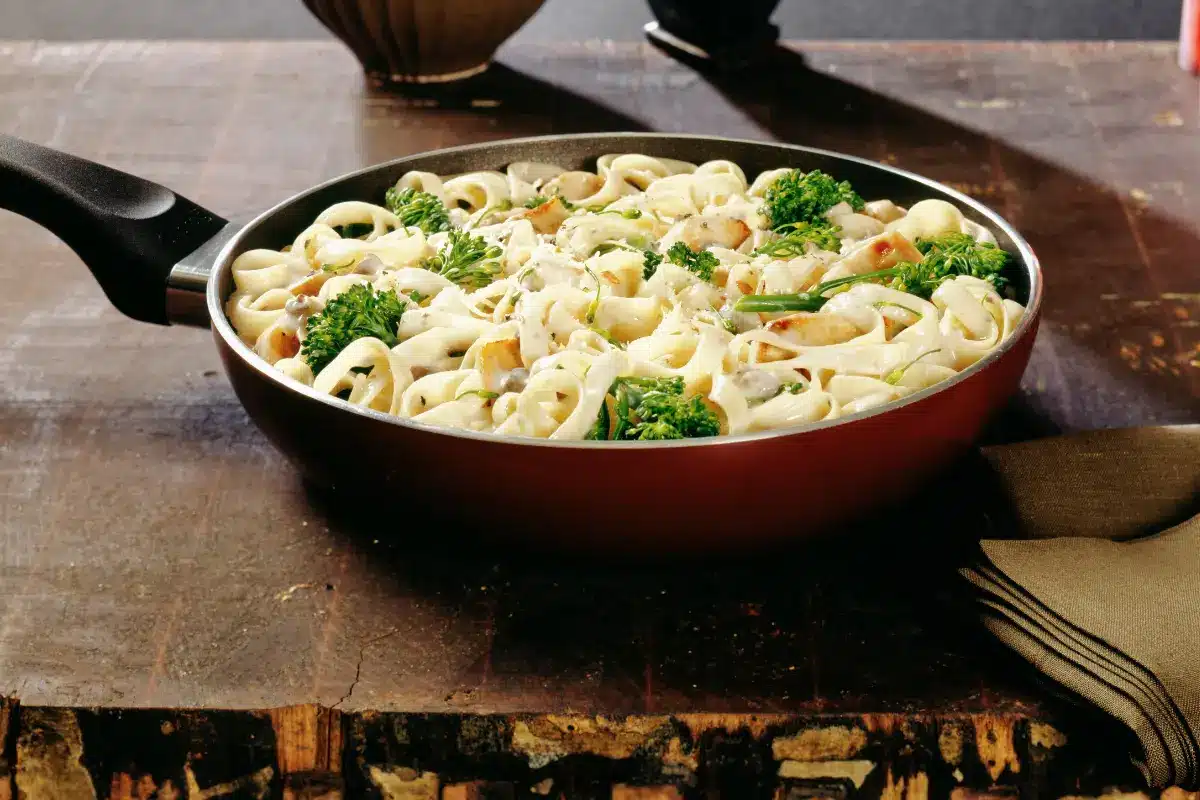Introduction to Broccoli Alfredo
Broccoli Alfredo combines the creamy, rich flavors of Alfredo sauce with the nutritious punch of broccoli. This dish is a testament to the magic that happens when simplicity meets sophistication. Originating from the heart of Italian cuisine, Broccoli Alfredo has found its way into the hearts and kitchens of food lovers worldwide.
Ingredients for the Perfect Broccoli Alfredo
- Broccoli : Fresh broccoli is preferred for its crispness and vibrant color. Look for firm, green florets with no signs of yellowing. You’ll need about 2 cups of broccoli florets, cut into bite-sized pieces. If fresh broccoli isn’t available, frozen broccoli can be a convenient substitute, though it may slightly alter the texture.
- Pasta : Fettuccine is the traditional choice for Alfredo dishes, thanks to its wide, flat surface that holds the sauce well. You’ll need about 8 ounces of pasta. However, you can substitute with other pasta types like penne or linguine based on preference or availability.
Alfredo Sauce:
- Butter: Start with ¼ cup of unsalted butter. This forms the base of the sauce and adds richness.
- Heavy Cream: You’ll need 1 cup of heavy cream for that creamy texture that Alfredo sauce is known for.
- Garlic: 2 cloves of minced garlic add a subtle flavor that complements the sauce without overpowering it.
- Parmesan Cheese: 1 cup of freshly grated Parmesan cheese is essential for the authentic Alfredo taste. It melts into the sauce, giving it a smooth texture and a slightly nutty flavor.
- Salt and Pepper: To taste, for seasoning the sauce and bringing out the flavors of the other ingredients.
- Olive Oil: A tablespoon of olive oil for sautéing the broccoli, enhancing its flavor and ensuring it’s perfectly cooked.
- Optional Ingredients:
- Nutmeg: A pinch of nutmeg can add depth to the Alfredo sauce.
- Red Pepper Flakes: For those who enjoy a bit of heat, a sprinkle of red pepper flakes can add a nice kick.
- Protein: Consider adding grilled chicken or shrimp to the dish for added protein and a more hearty meal.
- Garnish:
- Fresh Parsley: Chopped for a fresh, colorful garnish.
- Extra Parmesan Cheese: For serving, allowing individuals to add to their taste.
Preparation Tips:
- Ensure the broccoli is not overcooked; it should be tender but still offer a bit of crunch to contrast the creamy sauce.
- Cook the pasta al dente according to package instructions, as it will continue to absorb the sauce once mixed.
- For the Alfredo sauce, low heat is key to preventing the dairy from separating. Stir continuously for a smooth, velvety texture.
- Freshly grated Parmesan cheese melts better into the sauce compared to pre-grated cheese, which often contains anti-caking agents.
Step-by-Step Cooking Guide for the Perfect Broccoli Alfredo
 Creating a delicious Broccoli Alfredo dish is easier than you might think. Follow this step-by-step guide to ensure a creamy, flavorful, and perfectly cooked meal that will delight your taste buds.
Creating a delicious Broccoli Alfredo dish is easier than you might think. Follow this step-by-step guide to ensure a creamy, flavorful, and perfectly cooked meal that will delight your taste buds.Ingredients Preparation
The secret to a mouthwatering Broccoli Alfredo lies in its simple yet flavorful ingredients. Fresh broccoli florets, creamy Alfredo sauce, and your choice of pasta come together to create a dish that’s both satisfying and nutritious. For those looking to add a twist to their Alfredo, consider incorporating chocolate olive oil cake as a decadent dessert to round off the meal.
- Prepare the Broccoli: Wash 2 cups of broccoli florets and cut them into bite-sized pieces. If using frozen broccoli, thaw it first and drain any excess water.
- Grate the Parmesan Cheese: Grate 1 cup of Parmesan cheese and set it aside. Freshly grated cheese melts better and incorporates more smoothly into the sauce.
- Mince the Garlic: Peel and mince 2 cloves of garlic. Fresh garlic will give the sauce a more aromatic flavor compared to pre-minced garlic.
Cooking Steps
Starting with al dente pasta and moving on to perfectly sautéed broccoli, each step in preparing Broccoli Alfredo is designed to ensure a rich and comforting dish. The Alfredo sauce, with its creamy texture and cheesy flavor, is the heart of the recipe. For an added layer of coziness, why not share your meal alongside stories from the buttermilk pancake house experience, bringing a touch of diner warmth to your dining table?
Cooking the Pasta
- Boil Water: Fill a large pot with water, add a pinch of salt, and bring it to a boil.
- Cook the Pasta: Add 8 ounces of fettuccine to the boiling water and cook according to the package instructions until al dente. Stir occasionally to prevent the pasta from sticking together.
- Drain and Set Aside: Once cooked, drain the pasta and toss it with a little olive oil to prevent sticking. Keep it warm.
Cooking the Broccoli
- Heat Olive Oil: In a large skillet, heat 1 tablespoon of olive oil over medium heat.
- Sauté the Broccoli: Add the broccoli florets to the skillet. Sauté for about 4-5 minutes, or until the broccoli is tender but still crisp. Season with a pinch of salt and pepper to taste.
- Remove and Set Aside: Once cooked, remove the broccoli from the skillet and set it aside.
Making the Alfredo Sauce
- Melt Butter: In the same skillet, melt ¼ cup of unsalted butter over medium heat.
- Add Garlic: Add the minced garlic to the melted butter and sauté for about 1 minute, or until fragrant.
- Pour in Heavy Cream: Slowly add 1 cup of heavy cream to the skillet, stirring constantly. Allow the mixture to come to a simmer.
- Add Parmesan Cheese: Gradually add the grated Parmesan cheese to the cream mixture, stirring continuously until the cheese is fully melted and the sauce is smooth.
- Season the Sauce: Season with salt and pepper to taste. For a hint of warmth, you can add a pinch of nutmeg or red pepper flakes if desired.
- Combine with Broccoli: Add the sautéed broccoli to the sauce and stir to combine.
Assembling the Dish
- Combine Pasta and Sauce: Add the cooked pasta to the skillet with the broccoli and Alfredo sauce. Gently toss everything together over low heat until the pasta is well coated with the sauce.
- Adjust Consistency: If the sauce is too thick, you can add a little pasta water to reach your desired consistency.
Serving
- Plate Your Dish: Serve the Broccoli Alfredo on plates or in a large serving dish.
- Garnish: Sprinkle with additional grated Parmesan cheese and chopped fresh parsley for garnish.
- Serve Warm: Enjoy your Broccoli Alfredo while it’s warm for the best flavor and texture.
Tips
- Pasta Water: Reserve some pasta water before draining. The starchy water is great for adjusting the sauce’s consistency.
- Low Heat for Sauce: Keep the heat low when adding cheese to the sauce to prevent it from separating or becoming grainy.
- Fresh Ingredients: Use fresh ingredients whenever possible for the best flavor.
Follow these steps to create a comforting and delicious Broccoli Alfredo dish that’s perfect for any occasion. Enjoy your cooking journey!
Nutritional Benefits of Broccoli Alfredo
Broccoli Alfredo, a dish beloved for its creamy texture and comforting taste, also harbors a range of nutritional benefits. By breaking down the key components, we can uncover how this dish can be a part of a balanced diet.
Broccoli: A Nutrient Powerhouse
Broccoli is the star of this dish, not just for its flavor but for its impressive nutritional profile. It’s rich in:
- Vitamins C and K: Vitamin C is a powerful antioxidant that supports the immune system, while Vitamin K is crucial for bone health and wound healing.
- Fiber: Promotes digestive health and can aid in maintaining a healthy weight by providing a feeling of fullness.
- Folate: Essential for normal tissue growth and cell function, folate is particularly important for pregnant women.
- Minerals: Including iron, potassium, and magnesium, which are vital for various bodily functions, including maintaining a healthy heart and muscle function.
Pasta: Energy Provision
While pasta is often viewed with caution due to its carbohydrate content, it serves as an important energy source. Whole grain or whole wheat pasta options can provide:
- Complex Carbohydrates: These are broken down by the body more slowly, offering a sustained energy release.
- B-Vitamins: Necessary for converting food into energy.
- Fiber: In whole grain versions, fiber content is higher, which is beneficial for digestive health and can help in managing blood sugar levels.
Alfredo Sauce: Calcium and Protein
The Alfredo sauce, while rich and indulgent, contributes to the dish’s nutritional value through:
- Calcium: Provided by the Parmesan cheese, calcium is essential for bone health and maintaining heart and muscle function.
- Proteins: Cheese and cream are good sources of protein, which is crucial for building and repairing tissues.
Balancing the Meal
To make Broccoli Alfredo a more balanced part of your diet, consider the following tips:
- Portion Control: Enjoying this dish in moderation can help manage calorie intake while still benefiting from its nutrients.
- Incorporate Lean Proteins: Adding grilled chicken or shrimp can increase the protein content, making the meal more filling and nutritious.
- Choose Whole Grain Pasta: Opting for whole grain pasta can increase the dish’s fiber content, contributing to a more balanced meal.
- Add More Vegetables: Including additional vegetables such as spinach or mushrooms can boost the dish’s vitamin, mineral, and fiber content.
Conclusion
Broccoli Alfredo can be more than just a comfort food; with its combination of vitamins, minerals, and potential for added protein and fiber, it can serve as a satisfying part of a balanced diet. By being mindful of portions and making a few health-conscious choices, you can enjoy this delicious dish while also nourishing your body.
Variations of Broccoli Alfredo
Broccoli Alfredo, with its creamy sauce and tender broccoli, is a versatile dish that can be adapted to suit various dietary preferences and flavor profiles. Here are some delightful variations that can keep the essence of the original recipe while introducing new tastes and textures.
1. Gluten-Free Broccoli Alfredo
For those avoiding gluten, making a gluten-free version of Broccoli Alfredo is straightforward:
- Pasta: Use gluten-free pasta options available in the market, such as those made from rice, corn, or quinoa.
- Thickener: If the Alfredo sauce needs thickening, opt for gluten-free flour blends or cornstarch instead of traditional wheat flour.
2. Vegan Broccoli Alfredo
Creating a vegan version of this dish involves substituting dairy products with plant-based alternatives:
- Sauce: Use cashews blended with water, nutritional yeast, garlic, and salt to create a creamy, cheese-like sauce.
- Pasta: Ensure the pasta is egg-free, which most dried pastas are, but it’s always good to check the label.
- Broccoli: No changes needed here, as broccoli is already a vegan-friendly ingredient.
3. Chicken Broccoli Alfredo
Adding chicken to Broccoli Alfredo makes the dish more protein-rich and satisfying:
- Chicken: Grill or sauté chicken breasts, then slice them and add to the dish along with the broccoli.
- Preparation: Cook the chicken separately to ensure it’s properly seasoned and fully cooked before combining with the rest of the ingredients.
4. Shrimp Broccoli Alfredo
Incorporating shrimp offers a seafood twist to the classic recipe:
- Shrimp: Cook peeled and deveined shrimp until pink and opaque, then mix into the Alfredo sauce along with the broccoli.
- Flavor: Shrimp adds a delicate, sweet flavor that complements the creamy sauce and broccoli.
5. Whole Wheat Broccoli Alfredo
For a healthier take, whole wheat pasta can be used:
- Pasta: Substitute regular pasta with whole wheat pasta for added fiber and nutrients.
- Adjustments: Whole wheat pasta has a stronger, nuttier flavor that pairs well with the Alfredo sauce.
6. Spicy Broccoli Alfredo
For those who enjoy a bit of heat:
- Spice: Add red pepper flakes to the Alfredo sauce or top the finished dish with a sprinkle for an extra kick.
- Customization: The amount of spice can be adjusted to suit individual taste preferences.
7. Broccoli and Mushroom Alfredo
Adding mushrooms introduces an earthy flavor and additional texture:
- Mushrooms: Sauté sliced mushrooms until golden and mix them into the dish along with the broccoli.
- Variety: Choose from a variety of mushrooms like button, cremini, or portobello for different flavors.
Conclusion
These variations of Broccoli Alfredo demonstrate the dish’s flexibility and adaptability to different dietary needs and flavor preferences. Whether you’re looking for a healthier option, accommodating dietary restrictions, or simply in the mood for something new, there’s a version of Broccoli Alfredo that’s sure to satisfy.
Serving and Presentation Tips for Broccoli Alfredo
The presentation of Broccoli Alfredo can elevate this comforting dish from a simple meal to an impressive culinary creation. Here are some tips to enhance the serving and presentation of your Broccoli Alfredo, making it not only delicious but also visually appealing.
Choose the Right Dish
- Plates vs. Bowls: Serve Broccoli Alfredo in a shallow bowl or a wide, deep plate. These options cradle the pasta nicely and allow the sauce to be distributed evenly.
Garnishing for Color and Flavor
- Parsley: A sprinkle of freshly chopped parsley adds a pop of color and a fresh flavor contrast to the creamy sauce.
- Extra Parmesan: Offer additional grated Parmesan cheese on the side or lightly sprinkle it over the top for an extra touch of richness and flavor.
- Cracked Black Pepper: A twist of freshly cracked black pepper not only adds spice but also enhances the visual appeal of the dish.
- Lemon Zest: For a hint of brightness, a little lemon zest can be sprinkled on top. This adds a subtle fresh flavor that cuts through the richness of the Alfredo sauce.
Accompaniments
- Bread: Serve with a side of garlic bread or a crusty baguette to complement the creamy texture of the Alfredo sauce. Bread is perfect for sopping up any remaining sauce.
- Salad: A light, crisp salad with a vinaigrette dressing balances the richness of the Alfredo sauce, offering a refreshing contrast.
- Wine Pairing: A glass of white wine, such as Chardonnay or Pinot Grigio, pairs beautifully with the creamy sauce and the subtle flavors of broccoli and pasta.
Portion Control
- Moderation: Serve moderate portions to avoid overwhelming the plate. It’s always better to have guests wanting a bit more than to serve too much initially.
- Pasta Twirl: Use a serving fork or tongs to twirl the pasta into a neat nest in the center of the bowl or plate. This creates height and makes the dish look more elegant.
Attention to Detail
- Wipe the Edges: Before serving, wipe the edges of the plates or bowls to remove any drips or spills. Clean edges make the dish look more professional and appealing.
- Layering: Place the broccoli and any additional proteins like chicken or shrimp strategically on top of the pasta, ensuring they are visible and not buried under the sauce. This showcases all the components of your dish.
Serving Temperature
- Serve Hot: Broccoli Alfredo is best served hot, as the warmth enhances the flavors and keeps the sauce creamy. If needed, briefly reheat the dish before serving to ensure it’s at the perfect temperature.
Conclusion
With these serving and presentation tips, your Broccoli Alfredo will not only taste delicious but also look inviting and professional. Remember, the visual appeal of a dish can significantly impact the overall dining experience, making your meal memorable for all the right reasons.
Common Mistakes to Avoid When Making Broccoli Alfredo
Creating a delicious Broccoli Alfredo dish is relatively straightforward, but there are a few common pitfalls that can affect the outcome. Being aware of these mistakes can help you achieve a perfectly creamy, flavorful, and satisfying dish every time.
1. Overcooking the Broccoli
- Mistake: Cooking the broccoli until it’s mushy. Overcooked broccoli not only loses its vibrant green color but also its nutritional value and texture.
- Solution: Sauté or steam the broccoli until it’s just tender but still has a bit of crunch. This preserves its color, nutrients, and adds a nice texture contrast to the creamy Alfredo sauce.
2. Using Low-Quality Ingredients
- Mistake: Opting for pre-grated cheese, low-fat cream, or margarine instead of real butter can significantly affect the taste and texture of the Alfredo sauce.
- Solution: Use high-quality ingredients like real butter, heavy cream, and freshly grated Parmesan cheese. These contribute to a richer, more authentic flavor and creamy texture.
3. Not Properly Seasoning the Water
- Mistake: Forgetting to salt the pasta water. Pasta cooked in unsalted water can taste bland, even if the Alfredo sauce is well-seasoned.
- Solution: Generously salt the pasta water before adding the pasta. This is your only chance to season the pasta itself.
4. Cooking Pasta Too Long
- Mistake: Overcooking the pasta until it’s too soft. This can make the dish feel mushy and less enjoyable.
- Solution: Cook the pasta al dente, according to package instructions, so it retains some bite. It will continue to cook slightly when mixed with the hot Alfredo sauce.
5. Not Emulsifying the Sauce Properly
- Mistake: Rushing the sauce and ending up with a greasy or separated texture.
- Solution: Cook the sauce slowly and steadily, allowing the cheese to melt into the cream and butter mixture gradually. This creates a smooth, emulsified sauce.
6. Ignoring the Sauce Consistency
- Mistake: Making the Alfredo sauce too thick or too thin.
- Solution: Aim for a creamy consistency that’s not too heavy. If the sauce is too thick, you can thin it with a little pasta water. If it’s too thin, let it simmer a bit longer to reduce.
7. Not Tasting as You Go
- Mistake: Not tasting the dish during the cooking process can result in bland or overly salty flavors.
- Solution: Taste your sauce and adjust the seasoning as necessary before combining it with the pasta and broccoli. Remember, you can always add more salt, but you can’t take it away.
8. Skimping on the Garnish
- Mistake: Serving the dish without any garnish, which can make it look unappetizing.
- Solution: A simple garnish like freshly chopped parsley, extra grated Parmesan, or a light sprinkle of red pepper flakes can enhance both the flavor and appearance of the dish.
By avoiding these common mistakes, you can ensure your Broccoli Alfredo turns out perfectly creamy, flavorful, and visually appealing every time.
FAQs About Broccoli Alfredo
How to Add Broccoli to Alfredo?
Adding broccoli to Alfredo sauce is a great way to incorporate more vegetables into your meals, enhancing both the nutritional value and the flavor profile of the dish. Here’s how to do it:
- Prep the Broccoli: Wash and cut the broccoli into bite-sized florets. If you prefer softer broccoli, you can blanch it in boiling water for 1-2 minutes before adding it to the sauce. For a firmer texture, you can add it directly without blanching.
- Cook the Broccoli: Sauté the broccoli in a bit of olive oil or butter until it’s bright green and slightly tender. This usually takes about 4-5 minutes. Alternatively, you can steam the broccoli until it’s just tender.
- Combine with Alfredo Sauce: Once your Alfredo sauce is prepared and your pasta is cooked and drained, add the cooked broccoli to the sauce. Stir gently to combine, allowing the broccoli to warm through and absorb some of the sauce flavors.
- Serve: Serve the broccoli Alfredo over your choice of pasta, ensuring an even distribution of broccoli and sauce with each serving.
How to Make Broccoli Alfredo?
Making Broccoli Alfredo involves preparing a creamy Alfredo sauce, cooking pasta, and incorporating broccoli for a balanced and delicious dish. Here’s a simplified process:
- Cook Pasta: Start by boiling your choice of pasta (fettuccine is traditional) in salted water until al dente. Drain and set aside, reserving some pasta water for adjusting the sauce consistency later.
- Prepare Broccoli: While the pasta cooks, sauté or steam your broccoli florets until they’re just tender. Keep them bright green and slightly crisp for the best texture.
- Make Alfredo Sauce: In a large pan, melt butter and sauté minced garlic until fragrant. Add heavy cream and bring to a simmer. Gradually whisk in grated Parmesan cheese until the sauce is smooth and creamy. Season with salt and pepper to taste.
- Combine: Add the cooked pasta and broccoli to the Alfredo sauce, tossing gently to coat. If the sauce is too thick, add a bit of the reserved pasta water until you reach your desired consistency.
- Serve: Plate the Broccoli Alfredo, garnishing with extra Parmesan cheese and fresh parsley if desired.
Broccoli Alfredo Nutrition?
The nutritional content of Broccoli Alfredo can vary based on the specific ingredients and portion sizes used. However, here’s a general overview of what you can expect from a typical serving:
- Calories: A serving of Broccoli Alfredo can range from 400 to 600 calories, depending on the amounts of pasta, cheese, and cream used.
- Protein: Broccoli Alfredo is moderately high in protein, thanks to the cheese and milk in the Alfredo sauce, with about 15-20 grams per serving.
- Fat: This dish is high in fat due to the Alfredo sauce, which contains butter, cream, and cheese. A serving can have between 20-30 grams of fat.
- Carbohydrates: Pasta is a primary source of carbohydrates in this dish, contributing to 40-60 grams per serving.
- Fiber: Broccoli adds dietary fiber to the dish, with a serving providing 3-5 grams of fiber, which is beneficial for digestive health.
- Vitamins and Minerals: Broccoli is a rich source of vitamins C and K, folate, and minerals like potassium and calcium, contributing to the overall nutritional value of the dish.
For a healthier version, consider using whole wheat pasta, low-fat dairy options, and adding more broccoli to increase the fiber and nutrient content while reducing the calorie and fat content.
Conclusion
Broccoli Alfredo is more than just a dish; it’s a journey through flavors, textures, and nutritional benefits. Whether you’re a seasoned chef or a cooking novice, this guide aims to equip you with everything you need to create a delicious, comforting, and visually appealing meal that will leave your guests asking for seconds.



